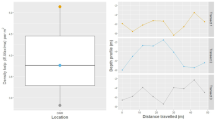Abstract
Accurate determination of diet is important in ecological studies. Many macrobenthic predators fragment their prey so finely that identification of component organisms is difficult. Knowledge of the food available to masticatory predators such as lobsters can help in determining potential prey and enhance the accuracy of dietary assessments. With SCUBA divers limited by depth and submersion time, benthic analyses are becoming increasingly reliant on camera systems. Here, based on paired samples, we assess the relative merits of using removal-sampling by divers versus monochrome video photography to determine the prey spectrum available to macrobenthic predators. We also relate the results to the gut contents of rock lobsters (Jasus lalandii) that were collected simultaneously. Diver samples took on average four times longer to collect and process than video-image samples. No significant differences were evident between the number of species identified in diver samples and video-image samples (n = 21 paired samples, Student's t = 0.233, P > 0.1), although an analysis of similarity (ANOSIM) test revealed that the results obtained from the two sampling methods were significantly different in terms of species composition (global R = 0.203, P < 0.01). Cluster analysis based on Bray–Curtis similarity to compare diver and video-image samples revealed four clusters of samples with <35% similarity, confirming that the two techniques do sample different assemblages of species. Video images detected and allowed identification of all species of prey recorded in the rock lobsters' stomach contents, probably because rock lobsters prey mainly on relatively large prey which are readily detected by video. Diver-sampling underestimated or failed to detect two important prey types, namely small barnacles and encrusting coralline algae. We concluded that the camera system employed was adequate for assessing the prey assemblages available to macrobenthic predators such as lobsters, and that it was considerably more economical than using divers.
Similar content being viewed by others
Author information
Authors and Affiliations
Additional information
Received: 10 September 1998 / Accepted: 6 May 1999
Rights and permissions
About this article
Cite this article
Mayfield, S., Branch, G. & Cockcroft, A. Determining prey availability for rock lobsters, Jasus lalandii : diver-sampling versus monochrome video photography. Marine Biology 135, 347–352 (1999). https://doi.org/10.1007/s002270050633
Issue Date:
DOI: https://doi.org/10.1007/s002270050633




